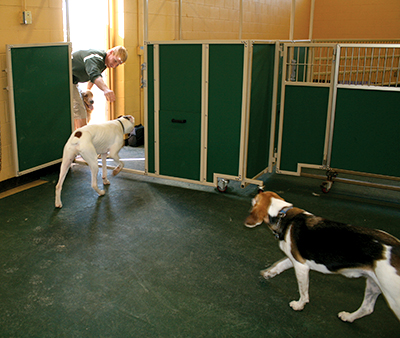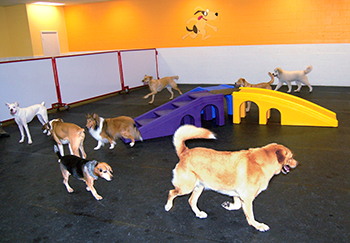
Divide and Conquer
Doggy Daycare Room Dividers Increase
Flexibility and Revenue.
By Tim Larson
In 2008 as the U. S. economy tanked, Camp Bow Wow nearly doubled its number of operating camps from 46 to 86. In 2011, job search website SimplyHired.com reported that listings for doggy daycare jobs had increased 2,791 percent since November 2009. Also in 2011, Americans spent $3.79 billion on pet services such as boarding and grooming. For 2012, the American Pet Products Association predicts the number will rise to $4.11 billion. Although the association doesn’t keep separate statistics on doggy daycare operations, you can be sure they are part of the equation.
Once they have the basic operation set up, many daycare operators look for ways to increase their revenue without substantially increasing their costs. Expanding their space is not an option. Dividing their space, however, is.

Dividers can be used to create a “meet and greet” area for dogs. (Photo courtesy of Stone Mountain Pet Lodge, Minneapolis.)
Some people use picket fences, chain link fences, or solid walls to partition their daycare space. While picket fences are cute, they’re not very durable when subjected to daily abuse by playful dogs. Chain link is relatively inexpensive, but it also imparts a prison-like appearance that many dog parents find off-putting, and you have to drill holes in the floor to anchor it. Solid walls are expensive, and you can’t take them with you if you decide to move to another location.
A moveable partition is the answer. Although some partitions may be made of vinyl fencing and PVC pipes, daycare owners know their customers have higher expectations.
Cascade Animal Medical Center is Rochester, Minnesota’s oldest small animal veterinary practice. It opened a doggy daycare center five years ago to fill a need for patients at the nearby Mayo Clinic. “We take care of dogs while people are getting treatment at Mayo,” said Jenny Mohawk, practice manager. “They may be in Rochester for two days or two weeks. Some hotels don’t take pets. Others do, but people don’t want to leave their pet alone all day in the hotel.”
Cascade has a grassy outdoor play yard, but the staff decided an indoor facility was needed. “We took an upstairs room at the clinic and divided it into three sections: two for play areas and one for a hallway for the dogs to move in and out.”

Wayne Regan of Dawg Gone It in Monterey, CA, separates play groups by size.
Instead of building walls or throwing up a chain link fence, the Cascade team decided on a T-shaped room divider and an additional 17.5-foot room divider, which can be moved as needs dictate. The longer divider creates a hallway that runs the length of the room. “We change the configuration about once a month, depending on the number of big dogs versus small dogs. It goes in spurts,” Jenny said.
Cascade now has an all-weather daycare facility. Jenny explained, “The best thing is that on 100-degree days or in winter, the dogs can play and romp around in the indoor play area.”
Megan Long is getting ready to open The Board Hound, a boarding kennel and daycare, in Arlington, Virginia. The daycare facility will serve 50 dogs. “We wanted something movable to divide the play area,” Megan said. She plans to separate dogs according to temperament. Her 52-foot room divider includes a vestibule that she uses as an evaluation area to determine temperament and play style.
She also wanted the option of using the room for training classes at night, which meant that the room divider needed to fold for storage. “Now I can have one big room or two temporary ones.”
The folding option was also important to Gail Fisher, owner of Gail Fisher’s All Dogs Gym and Inn in Manchester, New Hampshire. She has been in operation since 1993, starting out as a trainer and then adding daycare, boarding, private training, and classes. Hers is one of the first “interactive” doggy daycare centers in the country. She typically holds six training classes a night.

A guillotine door allows dogs to be moved one at a time. (Photo courtesy of Stone Mountain Pet Lodge, Minneapolis.)
In 2011, she decided to expand her 70-plus dog daycare operation to include a new training and socialization option for young puppies. As an alternative to knocking out a wall and adding on to her 12,000 square foot training area, she decided to take a corner of the arena and use it for her “Puppy Place.” She purchased an L-shaped room divider. Its HDPE plastic panels alternate a pattern of blue, red, and yellow in keeping with her “puppy kindergarten” theme.
“We use the training area for competitive events on weekends,” said Gail. “Some have exact specifications with regards to square footage—very exact. We take the divider walls down once a week and fold them up. They take up no space at all and don’t interfere with the competitions.”
Wayne Ragen is the owner of Dawg Gone It in Monterey, California. He typically has 30 dogs in daycare and boards 50 dogs overnight. “This is primarily an indoor facility. The logistics of getting 50 dogs out first thing in the morning could be a nightmare.” He explained, “I have four rooms. I could let four dogs out at a time. First outs could take all day!”
A castered room divider has become a real time-saver for him. He uses it to divide his four rooms into 12 spaces. “Now I can let 12 dogs out at a time.” He often uses the divider in the daycare room, where he divides the space into a two-thirds/one-third ratio, putting larger dogs in the larger space and small dogs in the smaller space. “I also use it as a barrier to herd dogs from one space to another,” Wayne added. “The appeal [of the room divider] was to reconfigure my rooms. It’s just what I wanted.“
All of these daycare operators have profited by employing room dividers to adapt their space for different uses. Creating new spaces from an existing space also gives them more control over the dogs they care for, whether it’s separating the meek from the feisty or moving them from one room to another. They can open and roll the dividers into storage for large group competitions or close them to conduct small group training sessions.
The demand for doggy daycare is still on the rise. Satisfying that demand doesn’t have to involve moving to a new location or adding on to your existing facility. By dividing your current space, you can expand your services and add revenue to your bottom line. That’s the kind of math every business owner loves!
Tim Larson is Sales Manager at Stone Mountain Pet Products, a Minnesota-based manufacturer of doggy daycare room divider systems. Visit www.stonemountainpetproducts.com or contact Tim at (763)450-3611 or [email protected].
Divide and Conquer
Things to consider:
- Do the dividers fold for storage?
- Are they easy to move?
- Do they have locking casters that improve the panels’ stability?
- Is the gap between the bottom of the panel and the floor small enough to prevent tiny dogs from escaping?
- Can the dividers be taken outside and pressure-washed for easy cleanup?
- If you move to another location, will the dividers move with you?
- Do you want to create a “vestibule” for daycare drop-offs?
- How do you want the divider to fit in your room? Straight across? Curved into a corner? T-shaped?
- What is the exact width of your room?
- Do you need an entryway for people?
- Do you need guillotine gates for moving dogs from one side of the room to the other?
- What panel style would fit your needs?
Full-height grille (allows dogs to see newcomers), grille top (handlers can see across the divider, dogs can’t), solid panels, or a combination?


